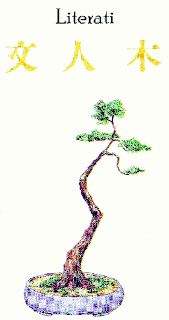 KENGAI
KENGAIThe difference between this style and the semi-cascade is thathere the trunk must fall below the base of the pot.
All other criteria are the same.
Good cascades are rare because of the difficulty in maintainingvigour in the lower parts of the tree, opposing its natural urgeto grow upwards.
This is probably the most difficult of all styles to designconvincingly, partly because of the horticultural problem, butmainly because we have few natural examples to recall asinspiration.
It is important to include dramatic features and sharp angles to evoke the feeling of a tree clinging to life in the harsh mountain conditions.
SHARIMIKI
Echoing the natural appearance of mountain junipers, whichproduce areas of bare, sun-bleached wood as they age, this styleis seldom successfully created from other species.
The focal point is the beautiful and dramatic shapes of the grainin the exposed wood.
These shapes may be natural but are more often elaboratelycarved and then bleached and preserved with lime-sulphur.
The foliage masses, although acknowledging some of the rulesof other styles, serve more as a foil or frame to the driftwood.
This style is suitable for conifers and rarely, if ever, applied todeciduous species of bonsai tree.
HOKIDACHI
This style was modelled on the natural habit of the zelkova andis seldom successfully used for other than related species, sinceit works best with trees bearing alternate foliage.
All branches should emerge from the top of a straight trunk andfork at regularly diminishing internals until a network of fineshoots at the tips forms an even-domed crown.
For broom styles to work well, they must be perfectly symmetricaland meticulously trained and pruned to ensure an even andgradual transition from trunk, through heavy branches, to thefinest terminal shoots.
Trying to rush the development will always end indisappointment.
This style is reminiscent of ancient pines, which tend to shedtheir lower branches as they get old.
It gets its name from the calligraphic style of ancient Chineseartists.
The focal point of the design is the trunk, so it should be full ofcharacter.
The branches are limited to the uppermost part of the trunk andshould bear just enough foliage to keep the tree healthy and vigorous.
The foliage should, however, be immaculately positioned.
The pots used for literati styles are generally round andcomparatively small to balance the sparse foliage.
They are also frequently’rustic’ in appearance, to re ect thetree’s rocky habitat.
SEKIJÔJU
In rocky terrain the scarce soil is constantly being eroded,
exposing the rocks and the roots of the trees growing amongstthem.
This style depicts such a tree whose roots, as they thicken, clingto any rocks beneath them.
The tree itself can be of any style, although broom and formalupright styles look out of place.
The most important factor is that the roots should cling tightlyto the rock and should have a mature texture.
This can take many years to accomplish.
First, the root-covered rock must first be planted in the groundfor several seasons to consolidate, and then exposed to the airand sun for the bark to develop mature characteristics.




0 commenti :
Post a Comment